Analysis of Australian Healthcare System Finance: Canada & Belgium
VerifiedAdded on 2022/11/13
|10
|2224
|482
Report
AI Summary
This report critically analyzes the Australian healthcare system by comparing and contrasting its financial structure and performance with those of Canada and Belgium, both OECD member countries. It examines the funding models, expenditure, and performance measures, including healthcare professional ratios, hospital infrastructure, and key health indicators such as cancer, coronary heart disease, and mental health. The analysis highlights the strengths and weaknesses of each system, identifying challenges faced by Australia, such as health insurance coverage and funding disparities. The report concludes with recommendations for improving the Australian healthcare system, focusing on balanced funding, increased investment in specific areas like cancer treatment, and expanding health insurance coverage to ensure equity and access for all citizens. The study uses data from various sources including the Australian Institute of Health and Welfare, Government of Canada, and OECD statistics to provide a comprehensive overview of the healthcare systems.
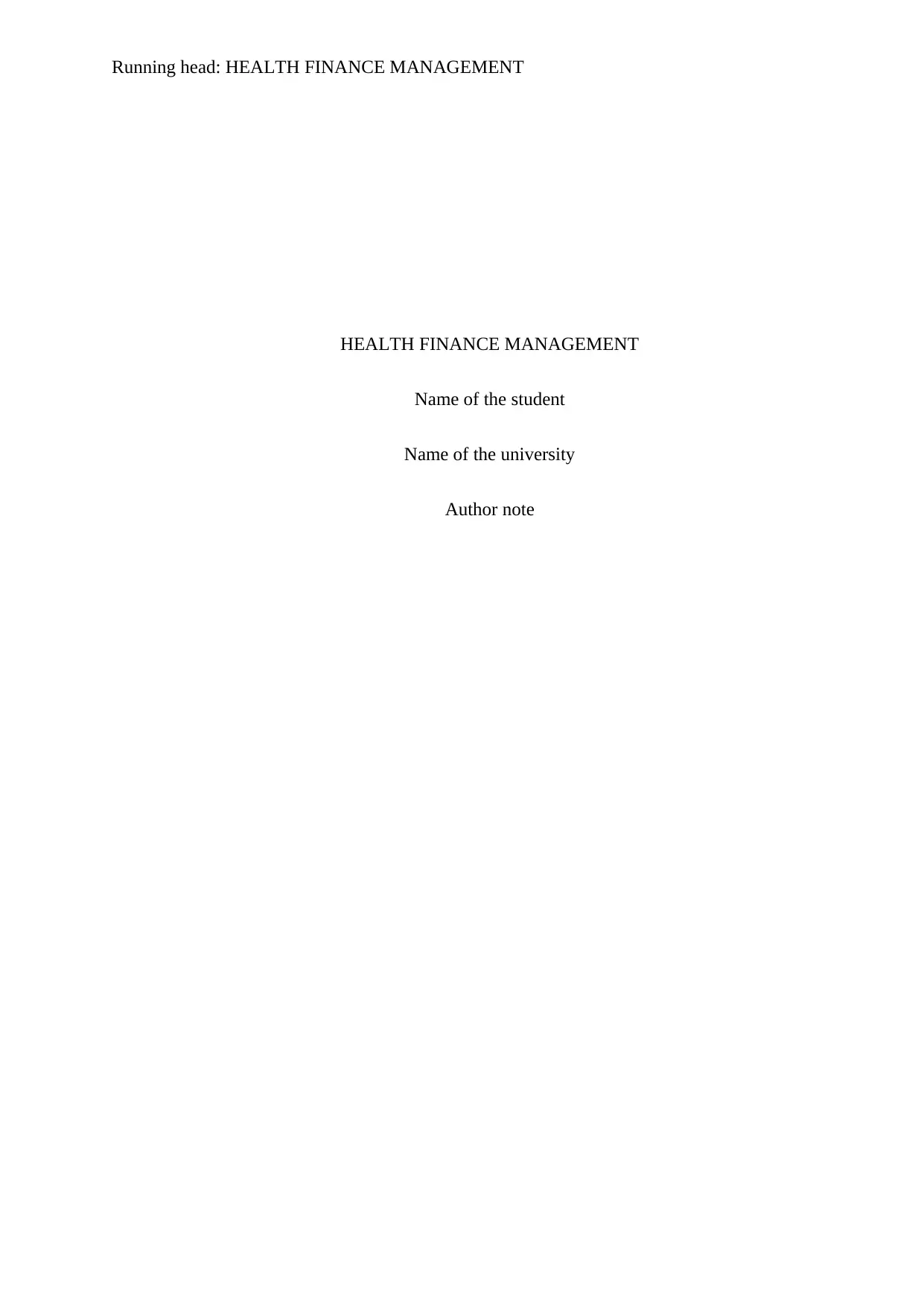
Running head: HEALTH FINANCE MANAGEMENT
HEALTH FINANCE MANAGEMENT
Name of the student
Name of the university
Author note
HEALTH FINANCE MANAGEMENT
Name of the student
Name of the university
Author note
Paraphrase This Document
Need a fresh take? Get an instant paraphrase of this document with our AI Paraphraser
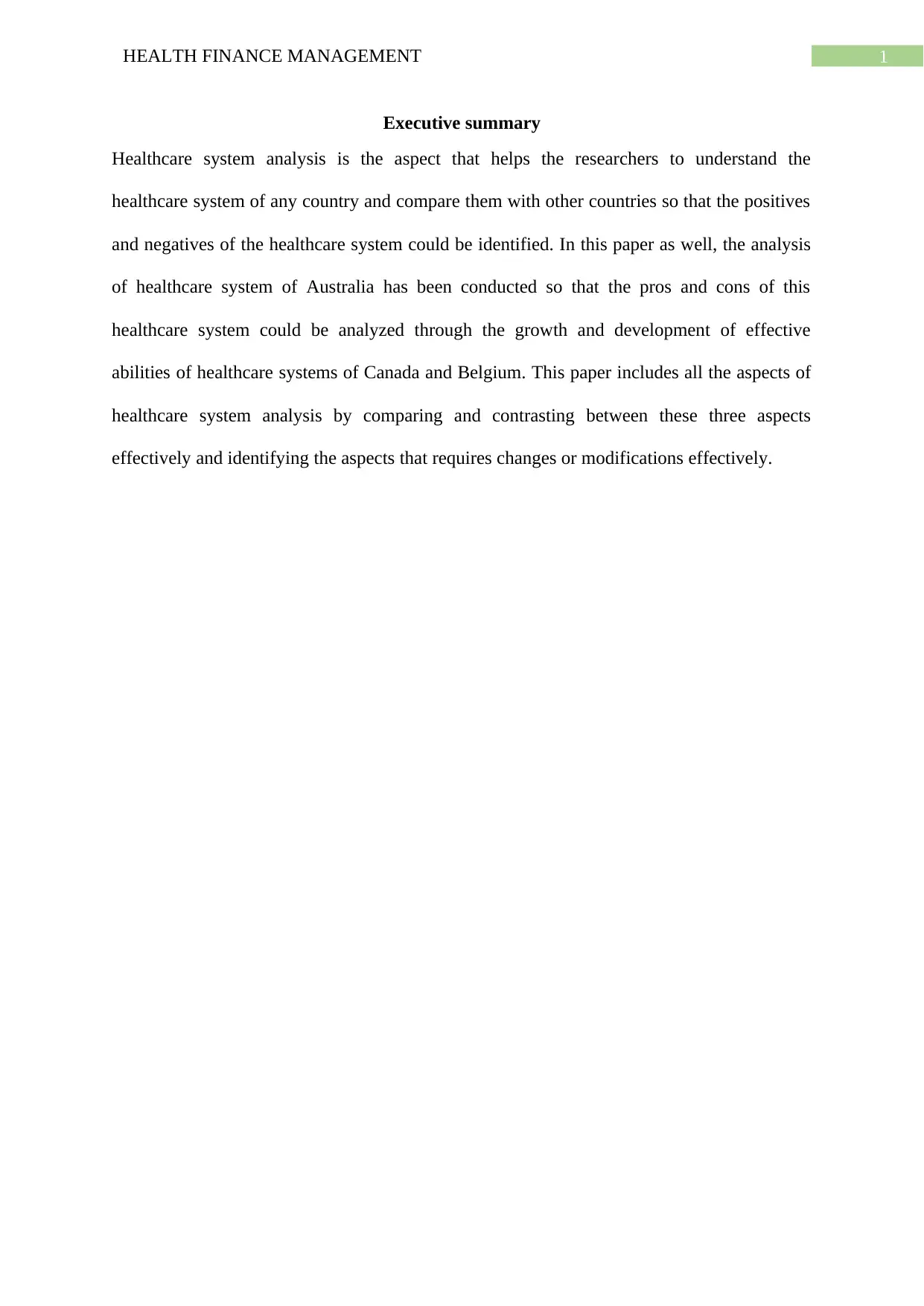
1HEALTH FINANCE MANAGEMENT
Executive summary
Healthcare system analysis is the aspect that helps the researchers to understand the
healthcare system of any country and compare them with other countries so that the positives
and negatives of the healthcare system could be identified. In this paper as well, the analysis
of healthcare system of Australia has been conducted so that the pros and cons of this
healthcare system could be analyzed through the growth and development of effective
abilities of healthcare systems of Canada and Belgium. This paper includes all the aspects of
healthcare system analysis by comparing and contrasting between these three aspects
effectively and identifying the aspects that requires changes or modifications effectively.
Executive summary
Healthcare system analysis is the aspect that helps the researchers to understand the
healthcare system of any country and compare them with other countries so that the positives
and negatives of the healthcare system could be identified. In this paper as well, the analysis
of healthcare system of Australia has been conducted so that the pros and cons of this
healthcare system could be analyzed through the growth and development of effective
abilities of healthcare systems of Canada and Belgium. This paper includes all the aspects of
healthcare system analysis by comparing and contrasting between these three aspects
effectively and identifying the aspects that requires changes or modifications effectively.
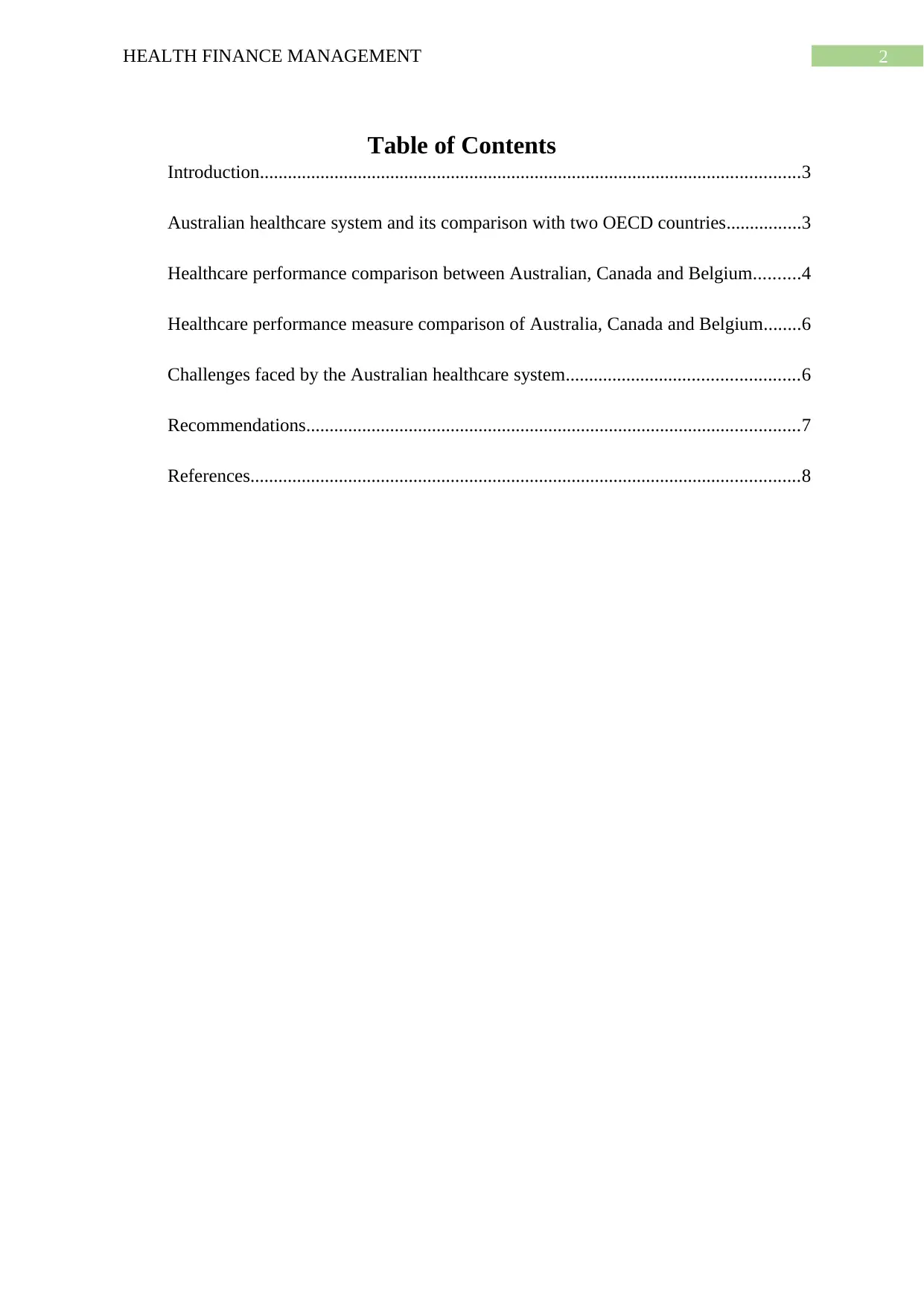
2HEALTH FINANCE MANAGEMENT
Table of Contents
Introduction....................................................................................................................3
Australian healthcare system and its comparison with two OECD countries................3
Healthcare performance comparison between Australian, Canada and Belgium..........4
Healthcare performance measure comparison of Australia, Canada and Belgium........6
Challenges faced by the Australian healthcare system..................................................6
Recommendations..........................................................................................................7
References......................................................................................................................8
Table of Contents
Introduction....................................................................................................................3
Australian healthcare system and its comparison with two OECD countries................3
Healthcare performance comparison between Australian, Canada and Belgium..........4
Healthcare performance measure comparison of Australia, Canada and Belgium........6
Challenges faced by the Australian healthcare system..................................................6
Recommendations..........................................................................................................7
References......................................................................................................................8
⊘ This is a preview!⊘
Do you want full access?
Subscribe today to unlock all pages.

Trusted by 1+ million students worldwide
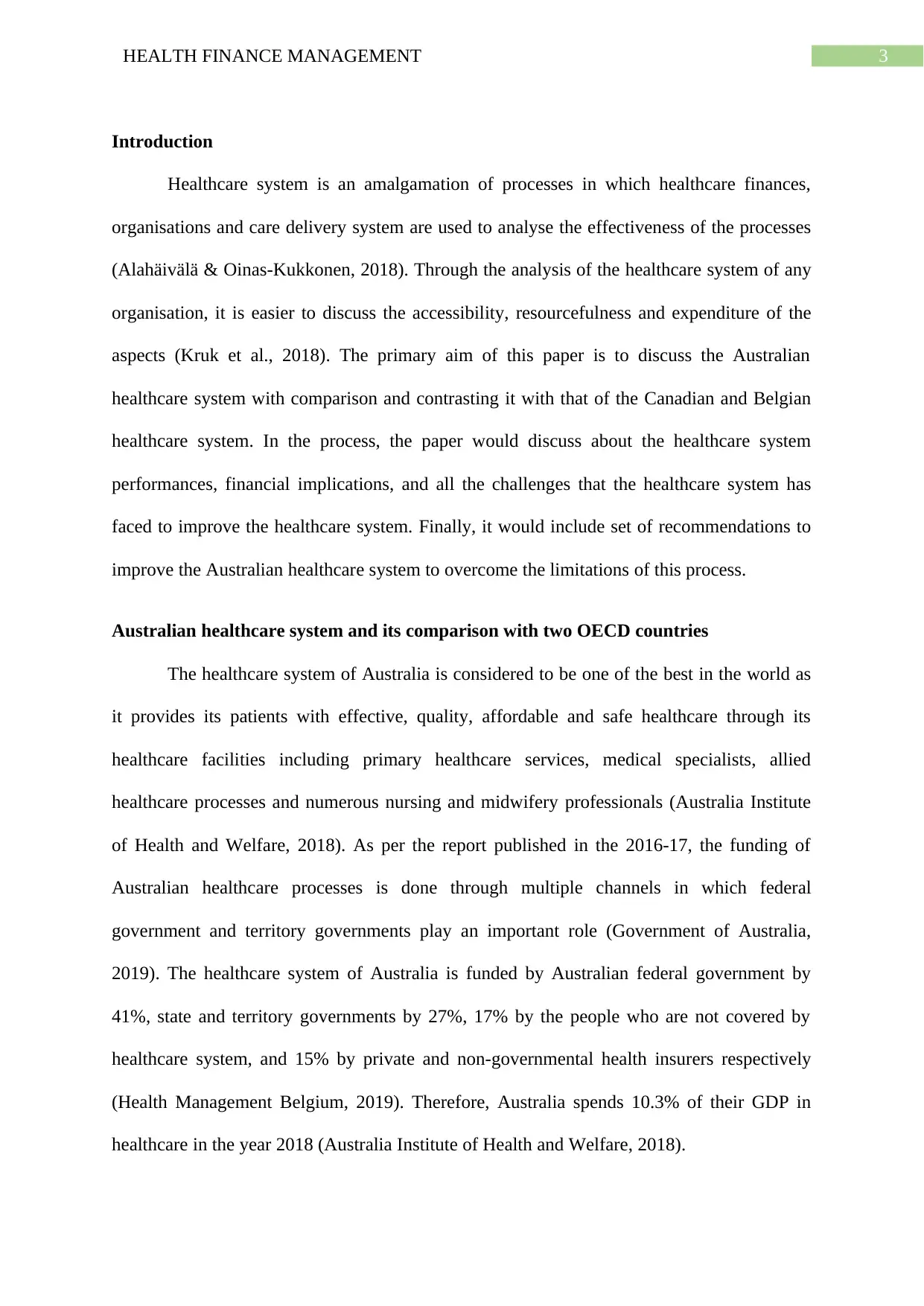
3HEALTH FINANCE MANAGEMENT
Introduction
Healthcare system is an amalgamation of processes in which healthcare finances,
organisations and care delivery system are used to analyse the effectiveness of the processes
(Alahäivälä & Oinas-Kukkonen, 2018). Through the analysis of the healthcare system of any
organisation, it is easier to discuss the accessibility, resourcefulness and expenditure of the
aspects (Kruk et al., 2018). The primary aim of this paper is to discuss the Australian
healthcare system with comparison and contrasting it with that of the Canadian and Belgian
healthcare system. In the process, the paper would discuss about the healthcare system
performances, financial implications, and all the challenges that the healthcare system has
faced to improve the healthcare system. Finally, it would include set of recommendations to
improve the Australian healthcare system to overcome the limitations of this process.
Australian healthcare system and its comparison with two OECD countries
The healthcare system of Australia is considered to be one of the best in the world as
it provides its patients with effective, quality, affordable and safe healthcare through its
healthcare facilities including primary healthcare services, medical specialists, allied
healthcare processes and numerous nursing and midwifery professionals (Australia Institute
of Health and Welfare, 2018). As per the report published in the 2016-17, the funding of
Australian healthcare processes is done through multiple channels in which federal
government and territory governments play an important role (Government of Australia,
2019). The healthcare system of Australia is funded by Australian federal government by
41%, state and territory governments by 27%, 17% by the people who are not covered by
healthcare system, and 15% by private and non-governmental health insurers respectively
(Health Management Belgium, 2019). Therefore, Australia spends 10.3% of their GDP in
healthcare in the year 2018 (Australia Institute of Health and Welfare, 2018).
Introduction
Healthcare system is an amalgamation of processes in which healthcare finances,
organisations and care delivery system are used to analyse the effectiveness of the processes
(Alahäivälä & Oinas-Kukkonen, 2018). Through the analysis of the healthcare system of any
organisation, it is easier to discuss the accessibility, resourcefulness and expenditure of the
aspects (Kruk et al., 2018). The primary aim of this paper is to discuss the Australian
healthcare system with comparison and contrasting it with that of the Canadian and Belgian
healthcare system. In the process, the paper would discuss about the healthcare system
performances, financial implications, and all the challenges that the healthcare system has
faced to improve the healthcare system. Finally, it would include set of recommendations to
improve the Australian healthcare system to overcome the limitations of this process.
Australian healthcare system and its comparison with two OECD countries
The healthcare system of Australia is considered to be one of the best in the world as
it provides its patients with effective, quality, affordable and safe healthcare through its
healthcare facilities including primary healthcare services, medical specialists, allied
healthcare processes and numerous nursing and midwifery professionals (Australia Institute
of Health and Welfare, 2018). As per the report published in the 2016-17, the funding of
Australian healthcare processes is done through multiple channels in which federal
government and territory governments play an important role (Government of Australia,
2019). The healthcare system of Australia is funded by Australian federal government by
41%, state and territory governments by 27%, 17% by the people who are not covered by
healthcare system, and 15% by private and non-governmental health insurers respectively
(Health Management Belgium, 2019). Therefore, Australia spends 10.3% of their GDP in
healthcare in the year 2018 (Australia Institute of Health and Welfare, 2018).
Paraphrase This Document
Need a fresh take? Get an instant paraphrase of this document with our AI Paraphraser
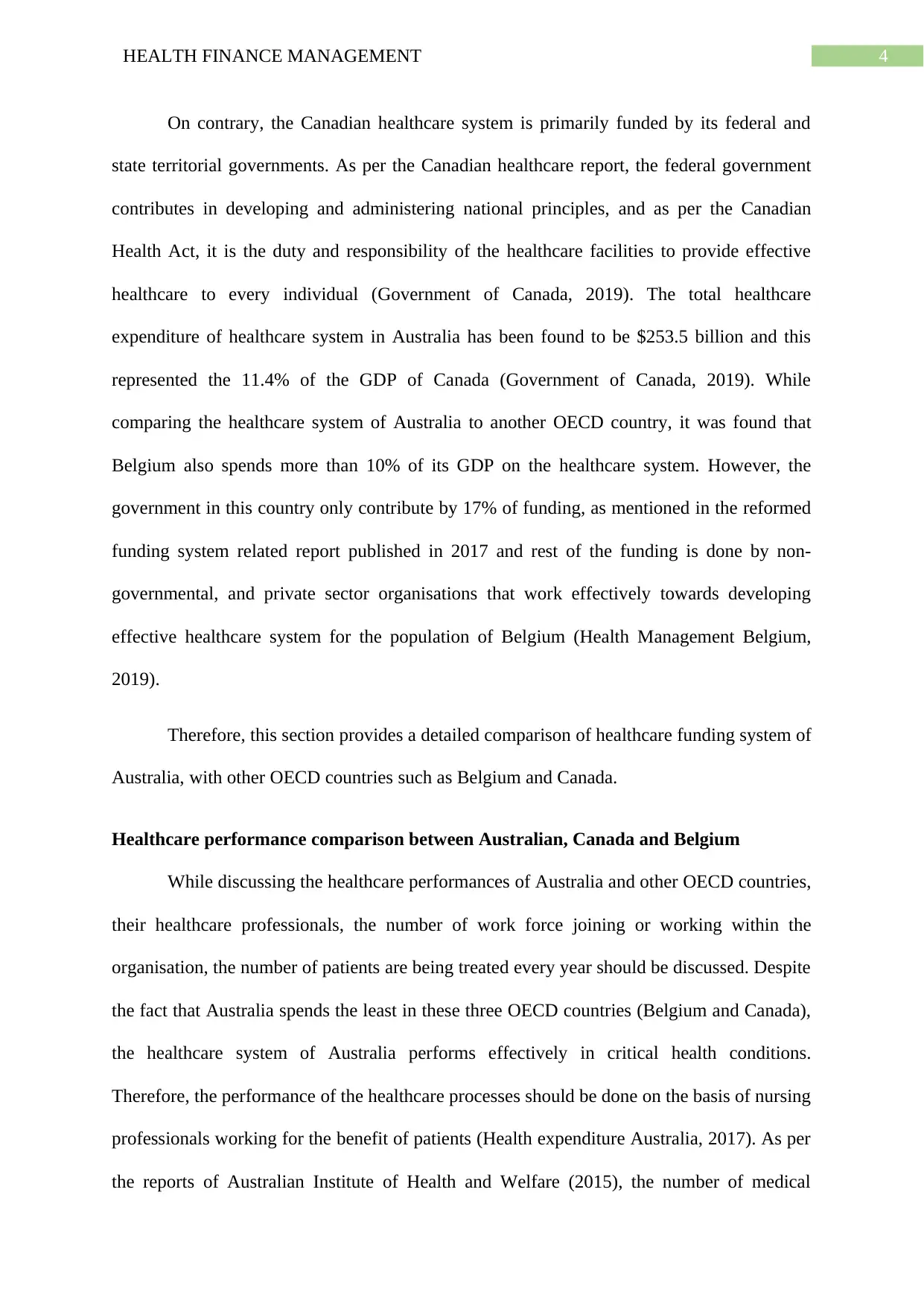
4HEALTH FINANCE MANAGEMENT
On contrary, the Canadian healthcare system is primarily funded by its federal and
state territorial governments. As per the Canadian healthcare report, the federal government
contributes in developing and administering national principles, and as per the Canadian
Health Act, it is the duty and responsibility of the healthcare facilities to provide effective
healthcare to every individual (Government of Canada, 2019). The total healthcare
expenditure of healthcare system in Australia has been found to be $253.5 billion and this
represented the 11.4% of the GDP of Canada (Government of Canada, 2019). While
comparing the healthcare system of Australia to another OECD country, it was found that
Belgium also spends more than 10% of its GDP on the healthcare system. However, the
government in this country only contribute by 17% of funding, as mentioned in the reformed
funding system related report published in 2017 and rest of the funding is done by non-
governmental, and private sector organisations that work effectively towards developing
effective healthcare system for the population of Belgium (Health Management Belgium,
2019).
Therefore, this section provides a detailed comparison of healthcare funding system of
Australia, with other OECD countries such as Belgium and Canada.
Healthcare performance comparison between Australian, Canada and Belgium
While discussing the healthcare performances of Australia and other OECD countries,
their healthcare professionals, the number of work force joining or working within the
organisation, the number of patients are being treated every year should be discussed. Despite
the fact that Australia spends the least in these three OECD countries (Belgium and Canada),
the healthcare system of Australia performs effectively in critical health conditions.
Therefore, the performance of the healthcare processes should be done on the basis of nursing
professionals working for the benefit of patients (Health expenditure Australia, 2017). As per
the reports of Australian Institute of Health and Welfare (2015), the number of medical
On contrary, the Canadian healthcare system is primarily funded by its federal and
state territorial governments. As per the Canadian healthcare report, the federal government
contributes in developing and administering national principles, and as per the Canadian
Health Act, it is the duty and responsibility of the healthcare facilities to provide effective
healthcare to every individual (Government of Canada, 2019). The total healthcare
expenditure of healthcare system in Australia has been found to be $253.5 billion and this
represented the 11.4% of the GDP of Canada (Government of Canada, 2019). While
comparing the healthcare system of Australia to another OECD country, it was found that
Belgium also spends more than 10% of its GDP on the healthcare system. However, the
government in this country only contribute by 17% of funding, as mentioned in the reformed
funding system related report published in 2017 and rest of the funding is done by non-
governmental, and private sector organisations that work effectively towards developing
effective healthcare system for the population of Belgium (Health Management Belgium,
2019).
Therefore, this section provides a detailed comparison of healthcare funding system of
Australia, with other OECD countries such as Belgium and Canada.
Healthcare performance comparison between Australian, Canada and Belgium
While discussing the healthcare performances of Australia and other OECD countries,
their healthcare professionals, the number of work force joining or working within the
organisation, the number of patients are being treated every year should be discussed. Despite
the fact that Australia spends the least in these three OECD countries (Belgium and Canada),
the healthcare system of Australia performs effectively in critical health conditions.
Therefore, the performance of the healthcare processes should be done on the basis of nursing
professionals working for the benefit of patients (Health expenditure Australia, 2017). As per
the reports of Australian Institute of Health and Welfare (2015), the number of medical
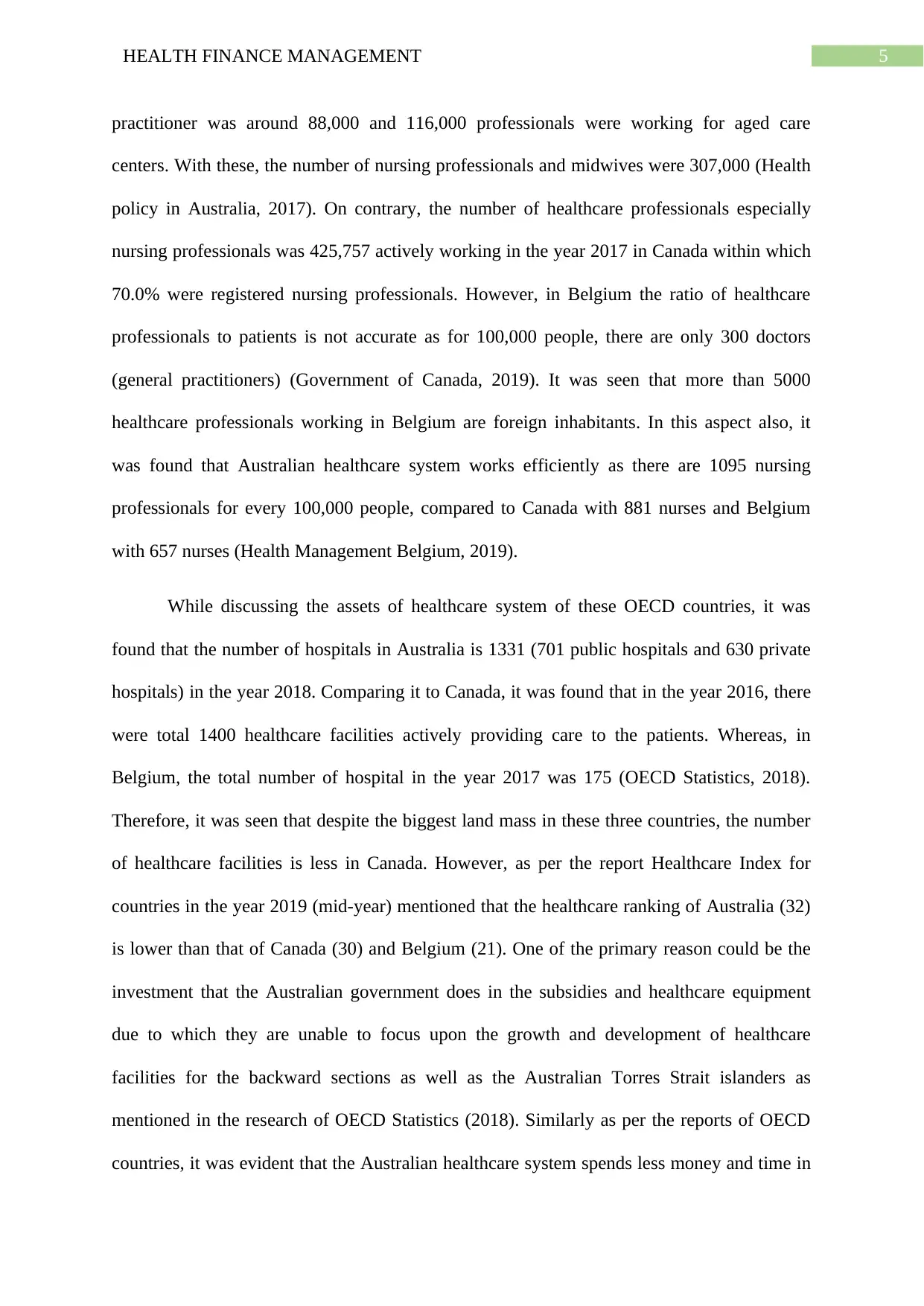
5HEALTH FINANCE MANAGEMENT
practitioner was around 88,000 and 116,000 professionals were working for aged care
centers. With these, the number of nursing professionals and midwives were 307,000 (Health
policy in Australia, 2017). On contrary, the number of healthcare professionals especially
nursing professionals was 425,757 actively working in the year 2017 in Canada within which
70.0% were registered nursing professionals. However, in Belgium the ratio of healthcare
professionals to patients is not accurate as for 100,000 people, there are only 300 doctors
(general practitioners) (Government of Canada, 2019). It was seen that more than 5000
healthcare professionals working in Belgium are foreign inhabitants. In this aspect also, it
was found that Australian healthcare system works efficiently as there are 1095 nursing
professionals for every 100,000 people, compared to Canada with 881 nurses and Belgium
with 657 nurses (Health Management Belgium, 2019).
While discussing the assets of healthcare system of these OECD countries, it was
found that the number of hospitals in Australia is 1331 (701 public hospitals and 630 private
hospitals) in the year 2018. Comparing it to Canada, it was found that in the year 2016, there
were total 1400 healthcare facilities actively providing care to the patients. Whereas, in
Belgium, the total number of hospital in the year 2017 was 175 (OECD Statistics, 2018).
Therefore, it was seen that despite the biggest land mass in these three countries, the number
of healthcare facilities is less in Canada. However, as per the report Healthcare Index for
countries in the year 2019 (mid-year) mentioned that the healthcare ranking of Australia (32)
is lower than that of Canada (30) and Belgium (21). One of the primary reason could be the
investment that the Australian government does in the subsidies and healthcare equipment
due to which they are unable to focus upon the growth and development of healthcare
facilities for the backward sections as well as the Australian Torres Strait islanders as
mentioned in the research of OECD Statistics (2018). Similarly as per the reports of OECD
countries, it was evident that the Australian healthcare system spends less money and time in
practitioner was around 88,000 and 116,000 professionals were working for aged care
centers. With these, the number of nursing professionals and midwives were 307,000 (Health
policy in Australia, 2017). On contrary, the number of healthcare professionals especially
nursing professionals was 425,757 actively working in the year 2017 in Canada within which
70.0% were registered nursing professionals. However, in Belgium the ratio of healthcare
professionals to patients is not accurate as for 100,000 people, there are only 300 doctors
(general practitioners) (Government of Canada, 2019). It was seen that more than 5000
healthcare professionals working in Belgium are foreign inhabitants. In this aspect also, it
was found that Australian healthcare system works efficiently as there are 1095 nursing
professionals for every 100,000 people, compared to Canada with 881 nurses and Belgium
with 657 nurses (Health Management Belgium, 2019).
While discussing the assets of healthcare system of these OECD countries, it was
found that the number of hospitals in Australia is 1331 (701 public hospitals and 630 private
hospitals) in the year 2018. Comparing it to Canada, it was found that in the year 2016, there
were total 1400 healthcare facilities actively providing care to the patients. Whereas, in
Belgium, the total number of hospital in the year 2017 was 175 (OECD Statistics, 2018).
Therefore, it was seen that despite the biggest land mass in these three countries, the number
of healthcare facilities is less in Canada. However, as per the report Healthcare Index for
countries in the year 2019 (mid-year) mentioned that the healthcare ranking of Australia (32)
is lower than that of Canada (30) and Belgium (21). One of the primary reason could be the
investment that the Australian government does in the subsidies and healthcare equipment
due to which they are unable to focus upon the growth and development of healthcare
facilities for the backward sections as well as the Australian Torres Strait islanders as
mentioned in the research of OECD Statistics (2018). Similarly as per the reports of OECD
countries, it was evident that the Australian healthcare system spends less money and time in
⊘ This is a preview!⊘
Do you want full access?
Subscribe today to unlock all pages.

Trusted by 1+ million students worldwide
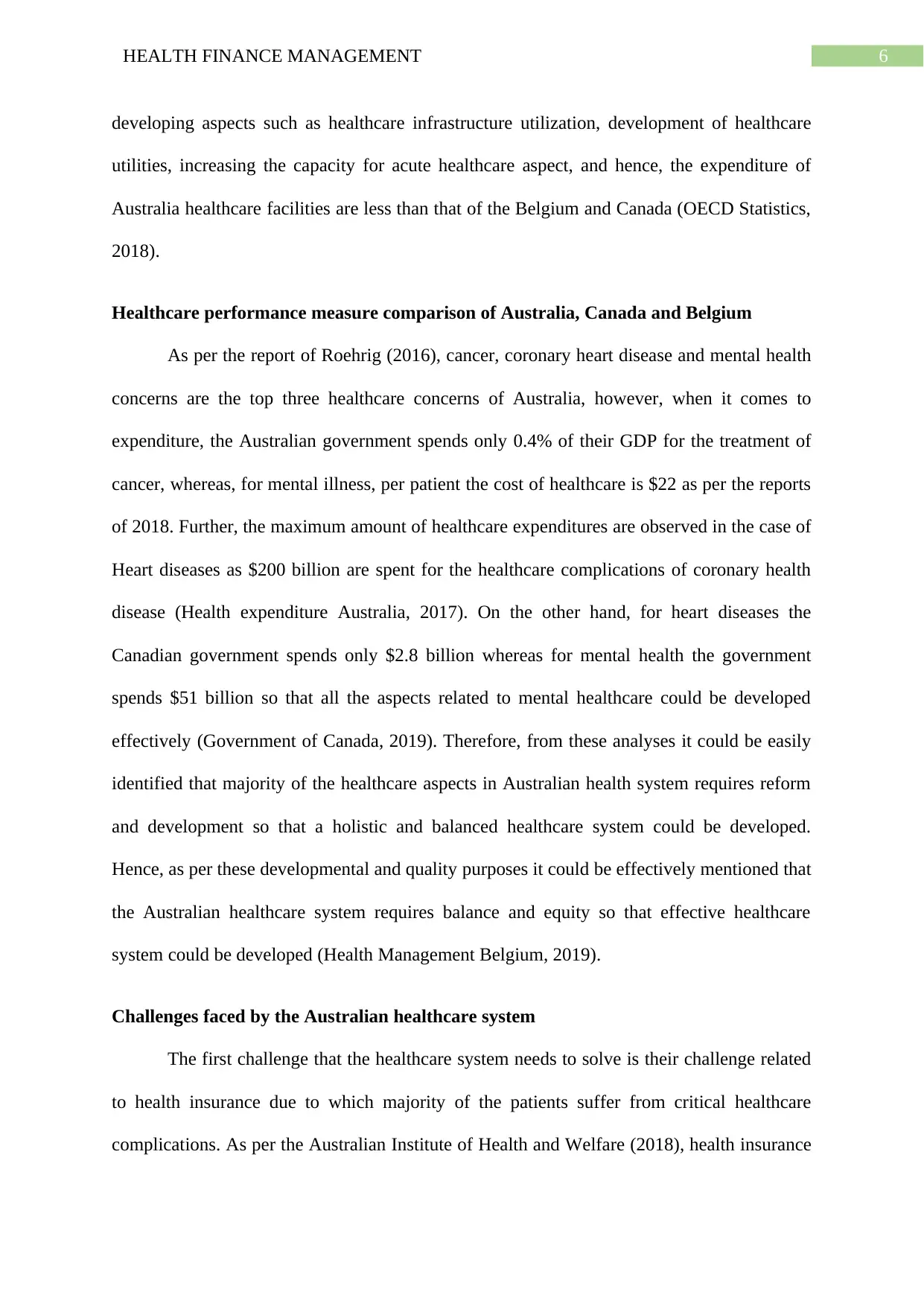
6HEALTH FINANCE MANAGEMENT
developing aspects such as healthcare infrastructure utilization, development of healthcare
utilities, increasing the capacity for acute healthcare aspect, and hence, the expenditure of
Australia healthcare facilities are less than that of the Belgium and Canada (OECD Statistics,
2018).
Healthcare performance measure comparison of Australia, Canada and Belgium
As per the report of Roehrig (2016), cancer, coronary heart disease and mental health
concerns are the top three healthcare concerns of Australia, however, when it comes to
expenditure, the Australian government spends only 0.4% of their GDP for the treatment of
cancer, whereas, for mental illness, per patient the cost of healthcare is $22 as per the reports
of 2018. Further, the maximum amount of healthcare expenditures are observed in the case of
Heart diseases as $200 billion are spent for the healthcare complications of coronary health
disease (Health expenditure Australia, 2017). On the other hand, for heart diseases the
Canadian government spends only $2.8 billion whereas for mental health the government
spends $51 billion so that all the aspects related to mental healthcare could be developed
effectively (Government of Canada, 2019). Therefore, from these analyses it could be easily
identified that majority of the healthcare aspects in Australian health system requires reform
and development so that a holistic and balanced healthcare system could be developed.
Hence, as per these developmental and quality purposes it could be effectively mentioned that
the Australian healthcare system requires balance and equity so that effective healthcare
system could be developed (Health Management Belgium, 2019).
Challenges faced by the Australian healthcare system
The first challenge that the healthcare system needs to solve is their challenge related
to health insurance due to which majority of the patients suffer from critical healthcare
complications. As per the Australian Institute of Health and Welfare (2018), health insurance
developing aspects such as healthcare infrastructure utilization, development of healthcare
utilities, increasing the capacity for acute healthcare aspect, and hence, the expenditure of
Australia healthcare facilities are less than that of the Belgium and Canada (OECD Statistics,
2018).
Healthcare performance measure comparison of Australia, Canada and Belgium
As per the report of Roehrig (2016), cancer, coronary heart disease and mental health
concerns are the top three healthcare concerns of Australia, however, when it comes to
expenditure, the Australian government spends only 0.4% of their GDP for the treatment of
cancer, whereas, for mental illness, per patient the cost of healthcare is $22 as per the reports
of 2018. Further, the maximum amount of healthcare expenditures are observed in the case of
Heart diseases as $200 billion are spent for the healthcare complications of coronary health
disease (Health expenditure Australia, 2017). On the other hand, for heart diseases the
Canadian government spends only $2.8 billion whereas for mental health the government
spends $51 billion so that all the aspects related to mental healthcare could be developed
effectively (Government of Canada, 2019). Therefore, from these analyses it could be easily
identified that majority of the healthcare aspects in Australian health system requires reform
and development so that a holistic and balanced healthcare system could be developed.
Hence, as per these developmental and quality purposes it could be effectively mentioned that
the Australian healthcare system requires balance and equity so that effective healthcare
system could be developed (Health Management Belgium, 2019).
Challenges faced by the Australian healthcare system
The first challenge that the healthcare system needs to solve is their challenge related
to health insurance due to which majority of the patients suffer from critical healthcare
complications. As per the Australian Institute of Health and Welfare (2018), health insurance
Paraphrase This Document
Need a fresh take? Get an instant paraphrase of this document with our AI Paraphraser
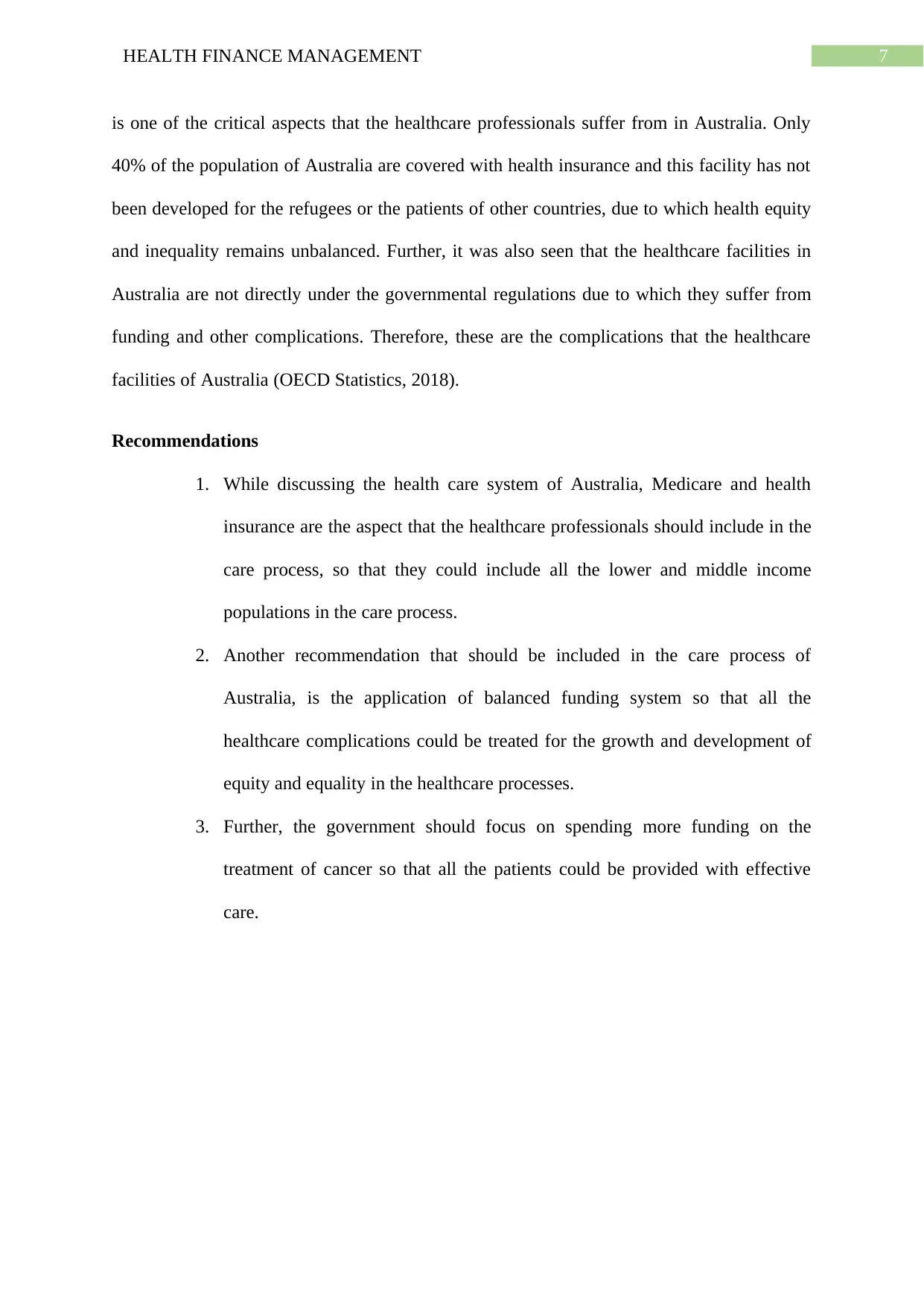
7HEALTH FINANCE MANAGEMENT
is one of the critical aspects that the healthcare professionals suffer from in Australia. Only
40% of the population of Australia are covered with health insurance and this facility has not
been developed for the refugees or the patients of other countries, due to which health equity
and inequality remains unbalanced. Further, it was also seen that the healthcare facilities in
Australia are not directly under the governmental regulations due to which they suffer from
funding and other complications. Therefore, these are the complications that the healthcare
facilities of Australia (OECD Statistics, 2018).
Recommendations
1. While discussing the health care system of Australia, Medicare and health
insurance are the aspect that the healthcare professionals should include in the
care process, so that they could include all the lower and middle income
populations in the care process.
2. Another recommendation that should be included in the care process of
Australia, is the application of balanced funding system so that all the
healthcare complications could be treated for the growth and development of
equity and equality in the healthcare processes.
3. Further, the government should focus on spending more funding on the
treatment of cancer so that all the patients could be provided with effective
care.
is one of the critical aspects that the healthcare professionals suffer from in Australia. Only
40% of the population of Australia are covered with health insurance and this facility has not
been developed for the refugees or the patients of other countries, due to which health equity
and inequality remains unbalanced. Further, it was also seen that the healthcare facilities in
Australia are not directly under the governmental regulations due to which they suffer from
funding and other complications. Therefore, these are the complications that the healthcare
facilities of Australia (OECD Statistics, 2018).
Recommendations
1. While discussing the health care system of Australia, Medicare and health
insurance are the aspect that the healthcare professionals should include in the
care process, so that they could include all the lower and middle income
populations in the care process.
2. Another recommendation that should be included in the care process of
Australia, is the application of balanced funding system so that all the
healthcare complications could be treated for the growth and development of
equity and equality in the healthcare processes.
3. Further, the government should focus on spending more funding on the
treatment of cancer so that all the patients could be provided with effective
care.
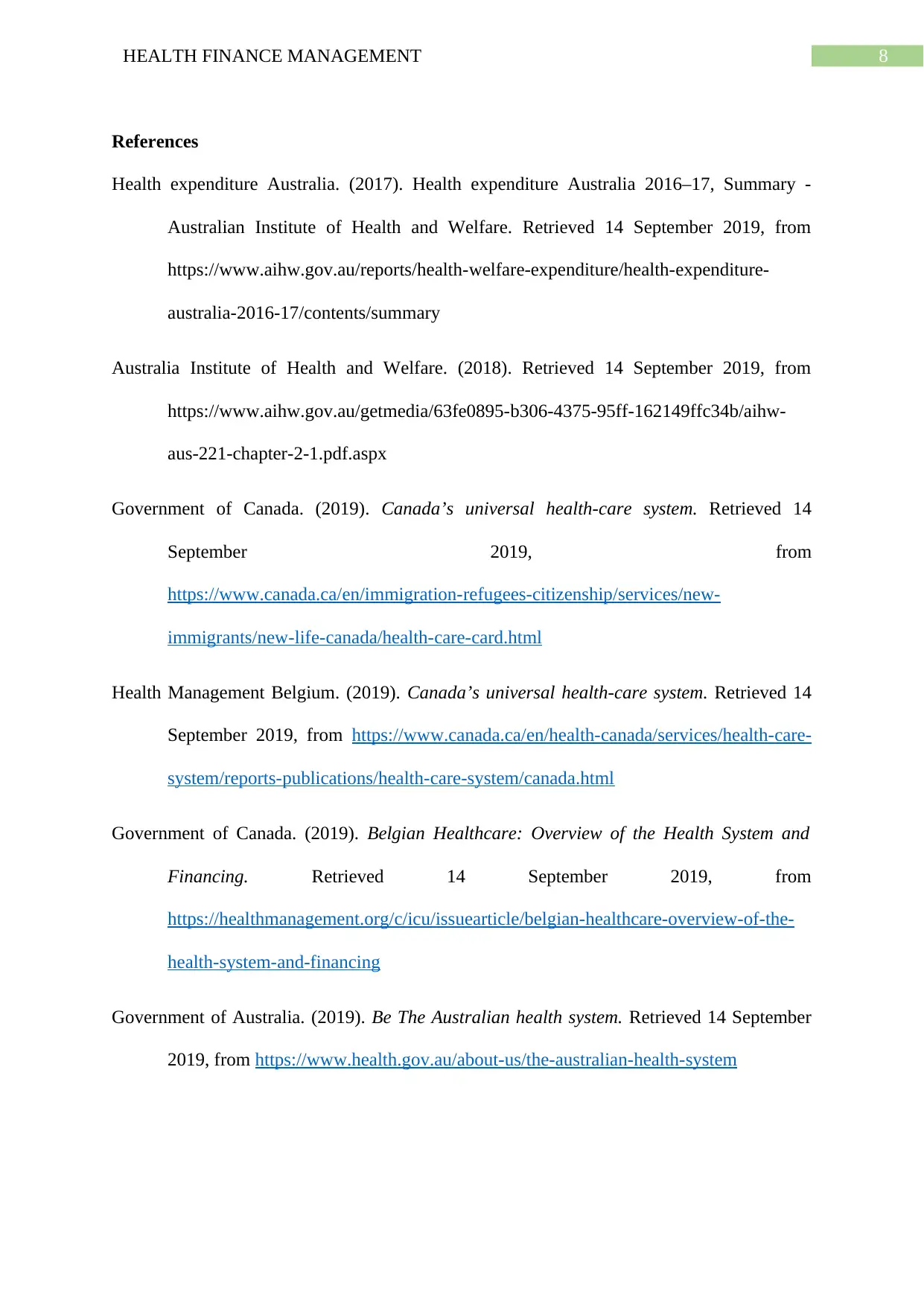
8HEALTH FINANCE MANAGEMENT
References
Health expenditure Australia. (2017). Health expenditure Australia 2016–17, Summary -
Australian Institute of Health and Welfare. Retrieved 14 September 2019, from
https://www.aihw.gov.au/reports/health-welfare-expenditure/health-expenditure-
australia-2016-17/contents/summary
Australia Institute of Health and Welfare. (2018). Retrieved 14 September 2019, from
https://www.aihw.gov.au/getmedia/63fe0895-b306-4375-95ff-162149ffc34b/aihw-
aus-221-chapter-2-1.pdf.aspx
Government of Canada. (2019). Canada’s universal health-care system. Retrieved 14
September 2019, from
https://www.canada.ca/en/immigration-refugees-citizenship/services/new-
immigrants/new-life-canada/health-care-card.html
Health Management Belgium. (2019). Canada’s universal health-care system. Retrieved 14
September 2019, from https://www.canada.ca/en/health-canada/services/health-care-
system/reports-publications/health-care-system/canada.html
Government of Canada. (2019). Belgian Healthcare: Overview of the Health System and
Financing. Retrieved 14 September 2019, from
https://healthmanagement.org/c/icu/issuearticle/belgian-healthcare-overview-of-the-
health-system-and-financing
Government of Australia. (2019). Be The Australian health system. Retrieved 14 September
2019, from https://www.health.gov.au/about-us/the-australian-health-system
References
Health expenditure Australia. (2017). Health expenditure Australia 2016–17, Summary -
Australian Institute of Health and Welfare. Retrieved 14 September 2019, from
https://www.aihw.gov.au/reports/health-welfare-expenditure/health-expenditure-
australia-2016-17/contents/summary
Australia Institute of Health and Welfare. (2018). Retrieved 14 September 2019, from
https://www.aihw.gov.au/getmedia/63fe0895-b306-4375-95ff-162149ffc34b/aihw-
aus-221-chapter-2-1.pdf.aspx
Government of Canada. (2019). Canada’s universal health-care system. Retrieved 14
September 2019, from
https://www.canada.ca/en/immigration-refugees-citizenship/services/new-
immigrants/new-life-canada/health-care-card.html
Health Management Belgium. (2019). Canada’s universal health-care system. Retrieved 14
September 2019, from https://www.canada.ca/en/health-canada/services/health-care-
system/reports-publications/health-care-system/canada.html
Government of Canada. (2019). Belgian Healthcare: Overview of the Health System and
Financing. Retrieved 14 September 2019, from
https://healthmanagement.org/c/icu/issuearticle/belgian-healthcare-overview-of-the-
health-system-and-financing
Government of Australia. (2019). Be The Australian health system. Retrieved 14 September
2019, from https://www.health.gov.au/about-us/the-australian-health-system
⊘ This is a preview!⊘
Do you want full access?
Subscribe today to unlock all pages.

Trusted by 1+ million students worldwide
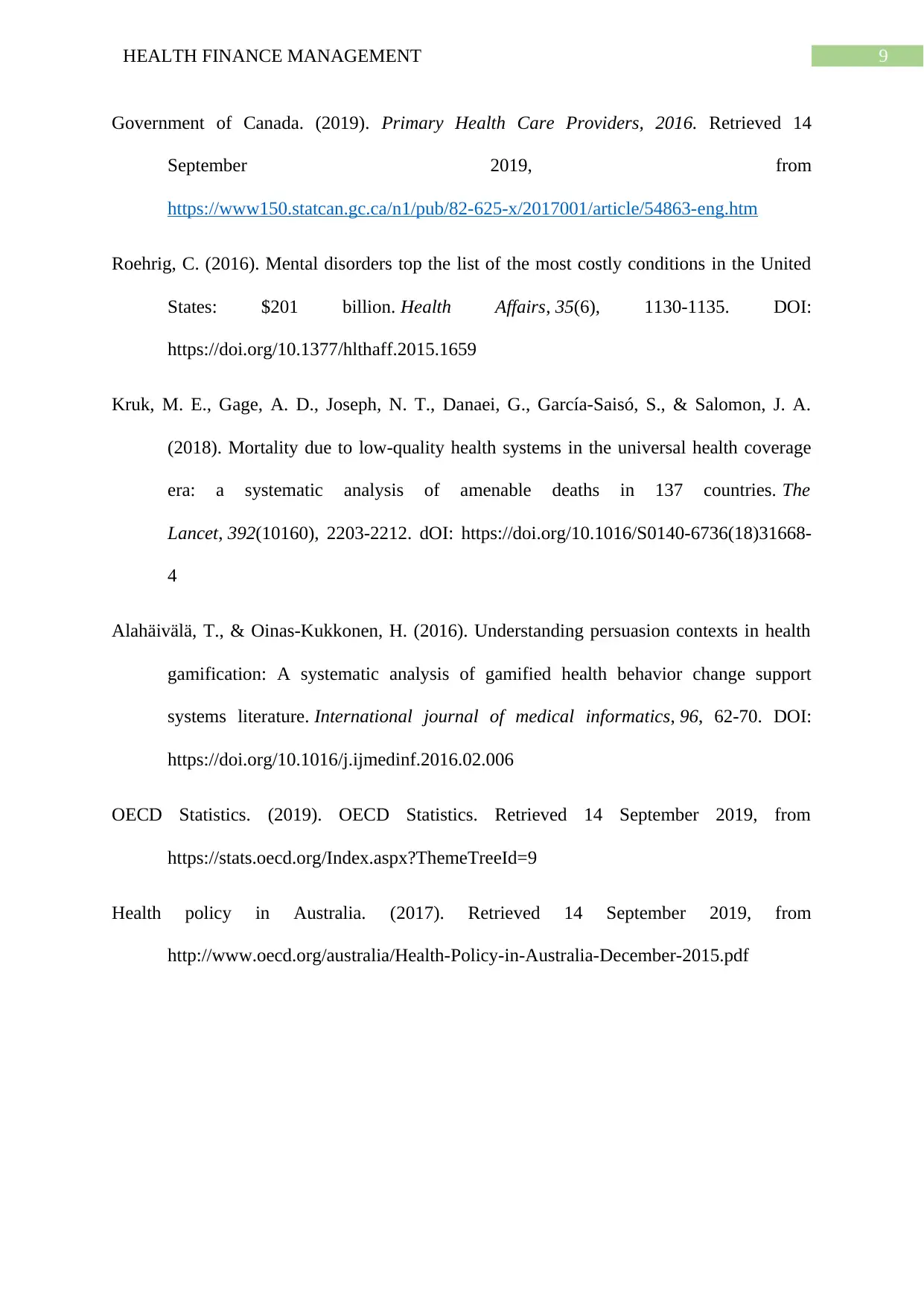
9HEALTH FINANCE MANAGEMENT
Government of Canada. (2019). Primary Health Care Providers, 2016. Retrieved 14
September 2019, from
https://www150.statcan.gc.ca/n1/pub/82-625-x/2017001/article/54863-eng.htm
Roehrig, C. (2016). Mental disorders top the list of the most costly conditions in the United
States: $201 billion. Health Affairs, 35(6), 1130-1135. DOI:
https://doi.org/10.1377/hlthaff.2015.1659
Kruk, M. E., Gage, A. D., Joseph, N. T., Danaei, G., García-Saisó, S., & Salomon, J. A.
(2018). Mortality due to low-quality health systems in the universal health coverage
era: a systematic analysis of amenable deaths in 137 countries. The
Lancet, 392(10160), 2203-2212. dOI: https://doi.org/10.1016/S0140-6736(18)31668-
4
Alahäivälä, T., & Oinas-Kukkonen, H. (2016). Understanding persuasion contexts in health
gamification: A systematic analysis of gamified health behavior change support
systems literature. International journal of medical informatics, 96, 62-70. DOI:
https://doi.org/10.1016/j.ijmedinf.2016.02.006
OECD Statistics. (2019). OECD Statistics. Retrieved 14 September 2019, from
https://stats.oecd.org/Index.aspx?ThemeTreeId=9
Health policy in Australia. (2017). Retrieved 14 September 2019, from
http://www.oecd.org/australia/Health-Policy-in-Australia-December-2015.pdf
Government of Canada. (2019). Primary Health Care Providers, 2016. Retrieved 14
September 2019, from
https://www150.statcan.gc.ca/n1/pub/82-625-x/2017001/article/54863-eng.htm
Roehrig, C. (2016). Mental disorders top the list of the most costly conditions in the United
States: $201 billion. Health Affairs, 35(6), 1130-1135. DOI:
https://doi.org/10.1377/hlthaff.2015.1659
Kruk, M. E., Gage, A. D., Joseph, N. T., Danaei, G., García-Saisó, S., & Salomon, J. A.
(2018). Mortality due to low-quality health systems in the universal health coverage
era: a systematic analysis of amenable deaths in 137 countries. The
Lancet, 392(10160), 2203-2212. dOI: https://doi.org/10.1016/S0140-6736(18)31668-
4
Alahäivälä, T., & Oinas-Kukkonen, H. (2016). Understanding persuasion contexts in health
gamification: A systematic analysis of gamified health behavior change support
systems literature. International journal of medical informatics, 96, 62-70. DOI:
https://doi.org/10.1016/j.ijmedinf.2016.02.006
OECD Statistics. (2019). OECD Statistics. Retrieved 14 September 2019, from
https://stats.oecd.org/Index.aspx?ThemeTreeId=9
Health policy in Australia. (2017). Retrieved 14 September 2019, from
http://www.oecd.org/australia/Health-Policy-in-Australia-December-2015.pdf
1 out of 10
Related Documents
Your All-in-One AI-Powered Toolkit for Academic Success.
+13062052269
info@desklib.com
Available 24*7 on WhatsApp / Email
![[object Object]](/_next/static/media/star-bottom.7253800d.svg)
Unlock your academic potential
Copyright © 2020–2025 A2Z Services. All Rights Reserved. Developed and managed by ZUCOL.





